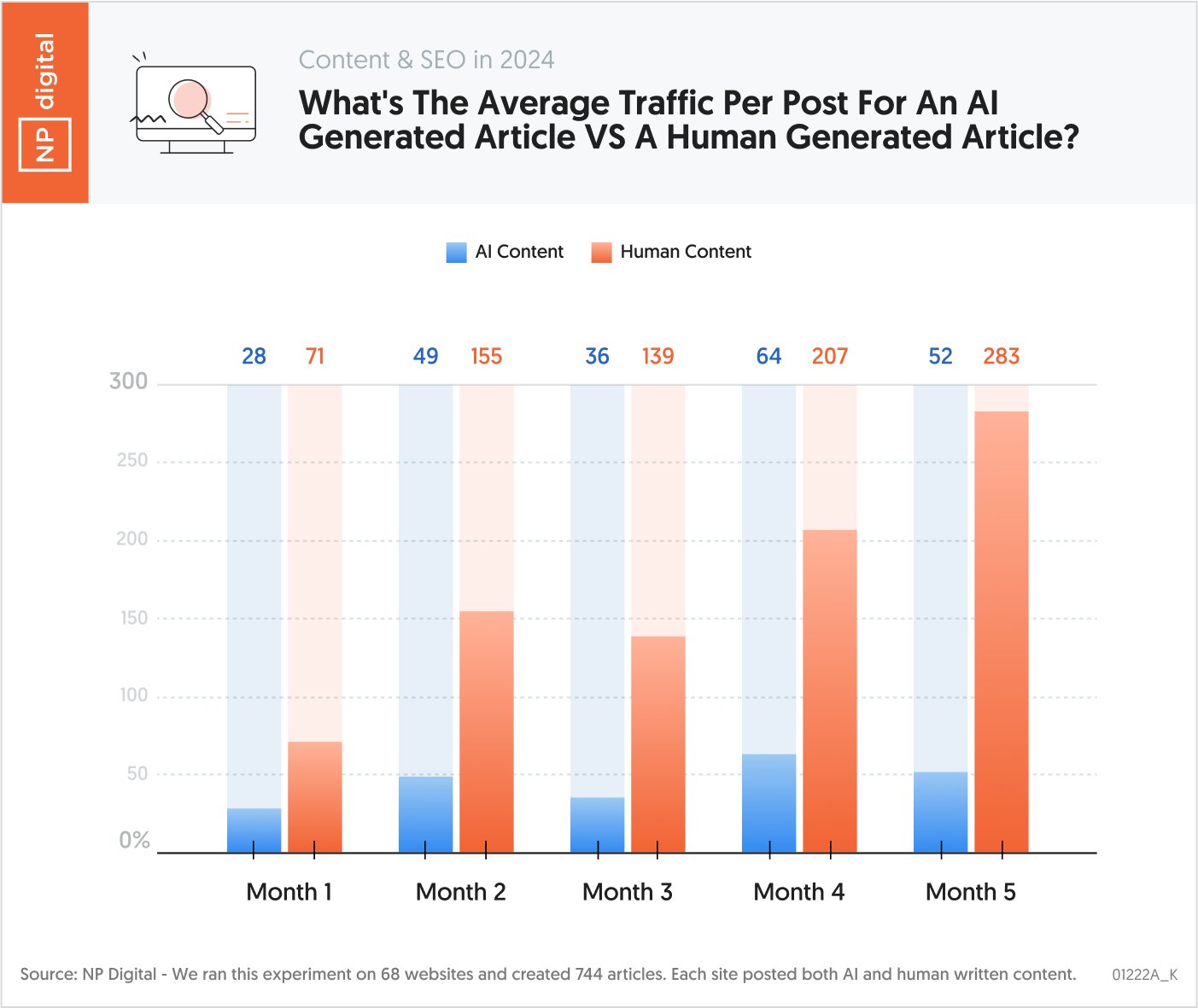Artificial intelligence (AI) is flipping the script in marketing. Thanks to data analysis and automation, ads are more on point, campaigns run smoother, and customers are more satisfied.
You’re missing out if you aren’t participating in conversations about how AI is transforming digital marketing.
In this post, we’ll break down what AI is doing in marketing, how you can leverage it, and some practical examples of AI marketing strategies that’ll transform your campaigns.
How is AI Transforming Digital Marketing?
It may seem like hype, but AI is expected to help increase personalization and drive greater product variety across all sectors. Research is predicting a 45% increase in global economic gains by 2030 thanks to AI:
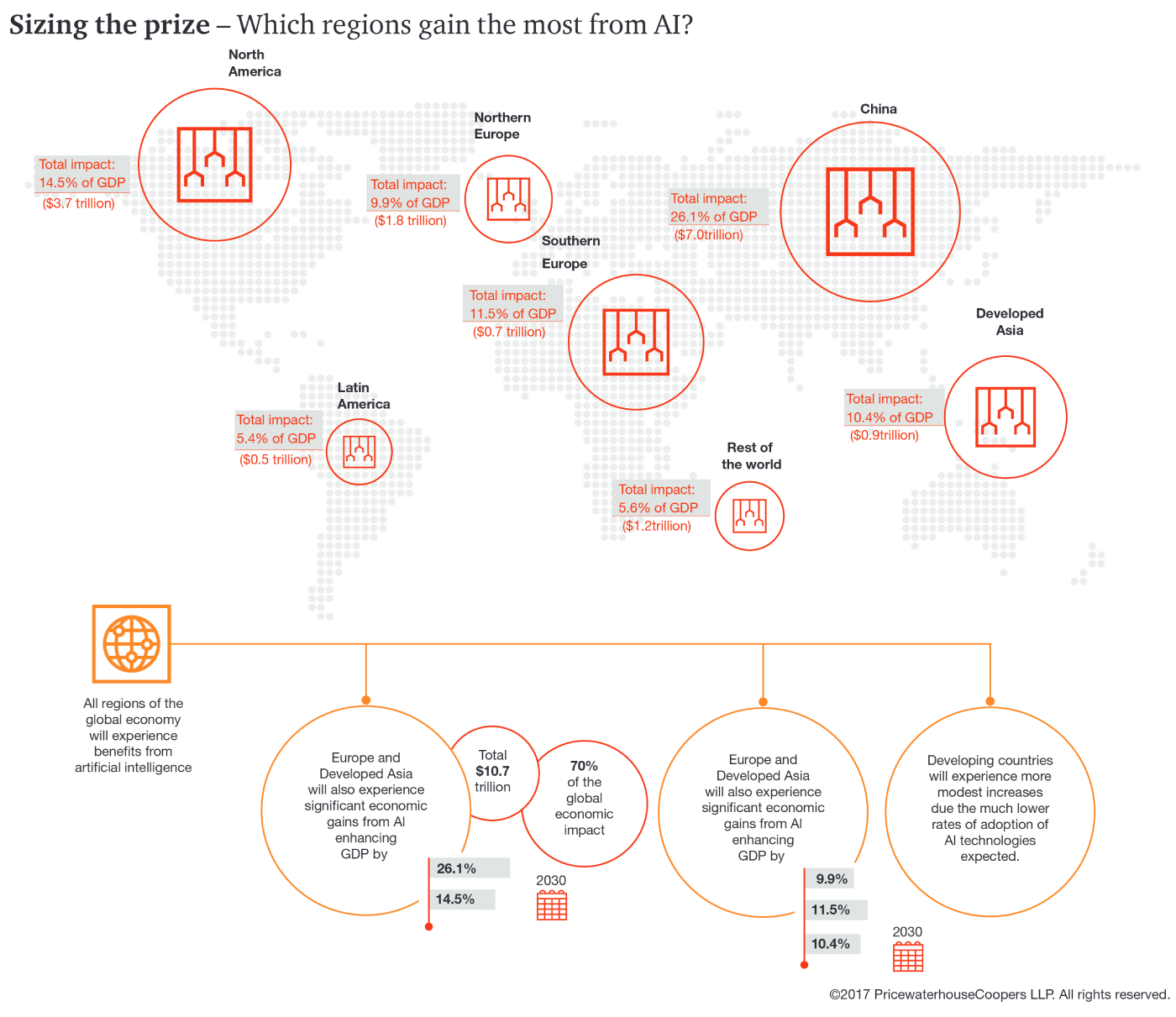
In digital marketing, AI is changing how we plan, execute, and optimize our marketing efforts, which in turn helps cut costs and improves performance while boosting customer satisfaction.
With AI marketing tools, you can analyze your agency’s raw data and turn it into actionable insights, automated actions, and content. It can also improve customer interactions by analyzing their behaviors and preferences and offering individualized service based on past interactions.
New AI tools are coming out every day that promise to level up marketing teams and help them work faster and smarter. There’s a lot of garbage to sift through, so we’ve done the work for you by coming up with 10 AI strategies for marketing + what AI tools you should use to get great results.
Pro tip: If you’re unfamiliar with AI marketing platforms and tools, check out our comprehensive guide to AI tools, where we go over some of the best tools available on the market right now.
10 Ways to Use AI in Digital Marketing
1. Data Analysis and Decision Making
AI is great at handling and analyzing large amounts of marketing data. You can use it to sift through massive amounts of data in no time and uncover insights that would be impossible to find manually. This means more informed decisions, smarter strategies, and better outcomes for your marketing campaigns.
AI tools can analyze consumer data, predict trends, and measure campaign performance with incredible accuracy. They can identify patterns and correlations that we humans might miss and provide insights into what’s working and what’s not.
Here are some useful tools and techniques that use AI for better data analysis:
- Use AI-powered analytics tools: Google Analytics 4, IBM Watson Analytics, and Adobe Analytics use AI to provide deeper insights and more accurate predictions. At Single Grain, we’ve used Google Analytics for over a decade to help our clients, and we now leverage its AI capabilities to generate reports and fine-tune our clients’ marketing efforts:
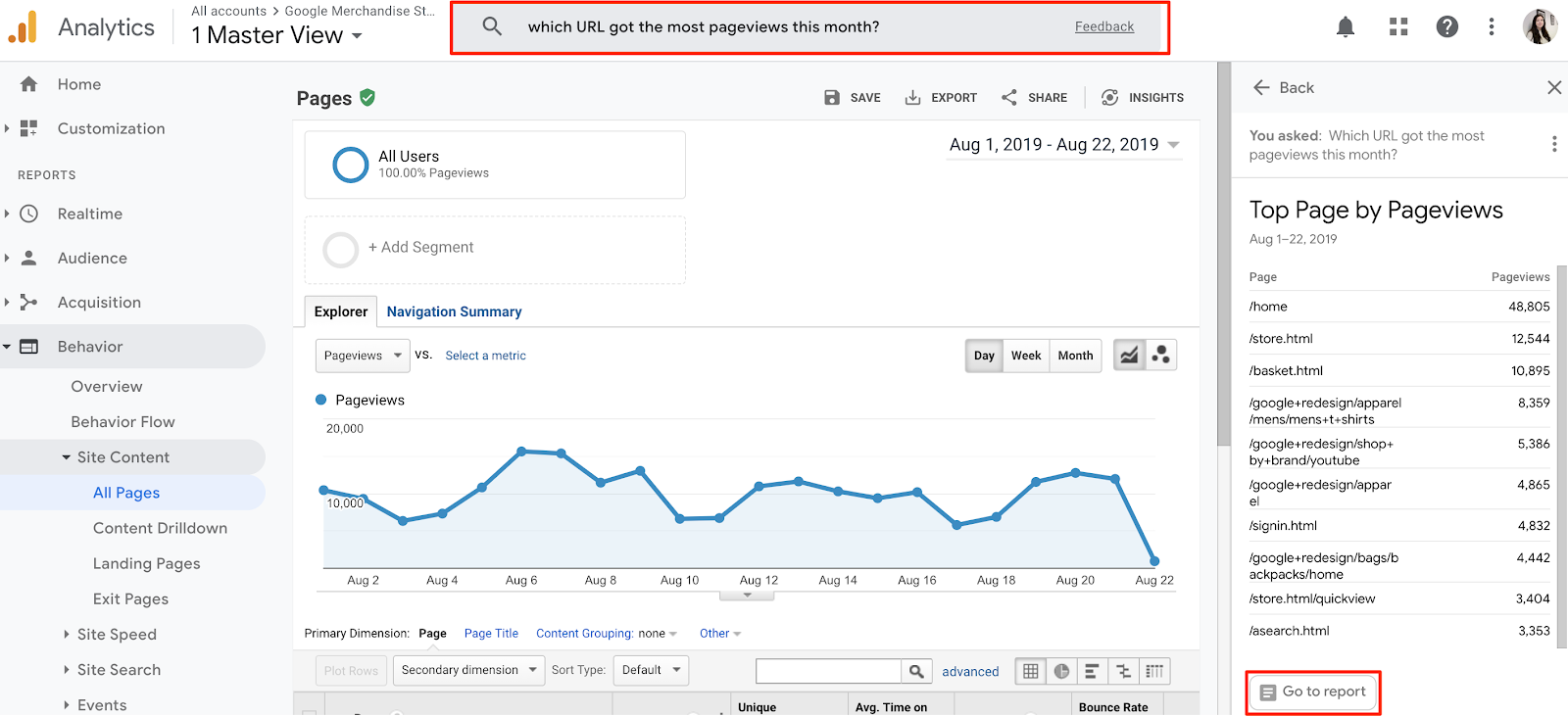
- Segment your audience: AI can help you segment your target audience more precisely by analyzing behavior, demographics, and other factors. Tools like HubSpot and Marketo can automate this process, ensuring your messages are highly targeted.
- Monitor social media: Use AI tools like Sprout Social or Brandwatch to analyze social media conversations and sentiment. This helps you understand how your brand is perceived and identify opportunities for engagement.
- Optimize ad campaigns: Platforms like Facebook Ads and Google Ads have offered AI tools to optimize your ad spend and improve targeting for almost a decade. They analyze performance data in real-time and adjust bids to maximize ROI:

Key Takeaway: AI’s power in data analysis and trend prediction changes the way businesses plan and make decisions.
2. Content Creation
AI content is everywhere now. Thanks to leaps in AI innovations, creating high-quality content has become faster, easier, and more efficient.
You can use tools like ChatGPT to generate engaging text, stunning visuals, and even personalized messages tailored to your audience’s preferences and needs.
But there’s a catch.
The gap in average traffic from AI-generated articles compared to human-written ones is significant:
AI-generated content tends to lack the nuance and creativity that human writers bring, which can result in lower engagement and traffic and poor search engine optimization. Additionally, Google’s March 2024 core update emphasizes quality, originality, and user experience, which are areas where human-written content excels.
While AI tools can enhance and streamline content creation, pivoting to entirely AI-generated content may not yield the best results. Human oversight and creativity remain vital to maintaining high-quality content that performs well in search rankings.
To put it simply: a balanced approach that integrates AI tools with human expertise is currently the most effective strategy for content creation.
That said, here are some ways companies are using AI in their content strategies:
- Use AI writing assistants as support tools: Tools like GPT-4, Jasper, and Writesonic can help you generate ideas for marketing messages, draft initial content, and refine your writing. However, always add a human touch to ensure the content is engaging and nuanced. Use these tools to overcome writer’s block or to speed up the drafting process, but don’t rely on them completely for final content:

- Automate content personalization with human oversight: Personalization tools like Persado and Phrasee can tailor your content to individual users. They analyze user data to determine what type of content and messaging will resonate most with each person. To maximize effectiveness, review and tweak AI-generated personalized messages to ensure they align with your brand voice and values.
- Create visual content with AI, but review for quality: AI tools like Canva’s Magic Switch and Adobe Spark use machine learning to help you create stunning visuals. They can automatically adjust the size and format of your designs to fit different platforms:
Key Takeaway: Use AI in content creation but maintain human oversight and creativity to produce more engaging, personalized, and effective content.
3. Chatbots for Customer Interaction
AI-powered chatbots have become a staple in customer service, providing instant responses and support around the clock. These chatbots can handle a wide range of tasks, from answering FAQs to guiding customers through complex processes.
With advancements in natural language processing (NLP) and machine learning, chatbots are becoming more conversational and capable of understanding customer needs better than ever before. They’re especially useful for sales support:

That said, chatbots aren’t perfect. They can struggle with complex or nuanced inquiries that require human empathy and creativity.
The best approach is to use chatbots to handle routine queries and free up human agents for more complex issues. This way your customers receive efficient service while still benefiting from human touch when needed.
Here are some practical tips for using AI-powered chatbots in customer interaction:
- Deploy chatbots for routine inquiries: Use chatbots to answer common questions and handle simple tasks like order tracking, appointment scheduling, and basic troubleshooting. This reduces the workload on human agents and ensures customers get quick responses to their queries.
- Integrate chatbots with human support: Ensure a seamless transition from chatbot to human agent for more complex issues. Tools like Intercom and Zendesk offer hybrid systems where chatbots handle initial interactions and hand over to humans when necessary. This provides a balance between efficiency and personalized service.
- Personalize interactions with data: Use customer data to personalize chatbot interactions. By accessing past interactions, purchase history, and preferences, chatbots can provide tailored recommendations and support. Platforms like Drift and ManyChat excel in creating personalized chatbot experiences.
- Provide clear escalation paths: Make sure your chatbot can easily escalate issues to human agents when needed. Clearly indicate to users how they can request human assistance, ensuring that more complex or sensitive issues are handled appropriately and promptly.
- Implement multi-channel chatbots: Deploy chatbots across various channels, including your website, social media, and messaging apps. Tools like Chatfuel allow you to manage chatbot interactions on platforms like Facebook Messenger, WhatsApp, and more, ensuring consistent support wherever your customers are.
Key Takeaway: By integrating AI-powered chatbots with your customer service strategy, you can provide quick, efficient, and personalized support.
4. Automated Email Marketing Campaigns
Ever get an email that feels like it was written just for you? AI is likely the reason.
Automated email marketing campaigns are transforming the way businesses engage with their customers. By using AI, companies can send personalized, timely, and relevant emails that drive higher engagement and conversion rates.
AI tools can automate the process of segmenting audiences, crafting tailored messages, and sending emails at optimal times, making email marketing more efficient and effective.
Of course, just like with using AI for content creation, you have to balance automation with a personal touch. An over-reliance on automated emails can lead to generic messaging and disengaged audiences. Human oversight is vital to ensure your campaigns remain impactful and engaging.
Pro tip: Want to learn more about email marketing tools? Check out our review of the 10 best email marketing tools based on factors like features and functionality, deliverability, scalability, and more!
Here are some practical tips for using AI in automated email marketing campaigns:
- Segment your audience automatically: Use AI tools like Mailchimp, HubSpot, and Sendinblue to automatically segment your email list based on user behavior, preferences, and demographics. This allows you to send targeted emails that resonate with specific segments, improving open and click-through rates.
- Personalize email content: Leverage AI to personalize email content for each recipient. Tools like Persado and Phrasee can analyze customer data to craft tailored subject lines and email body content that appeal to individual preferences. Personalization increases engagement and makes your emails feel more relevant and timely:
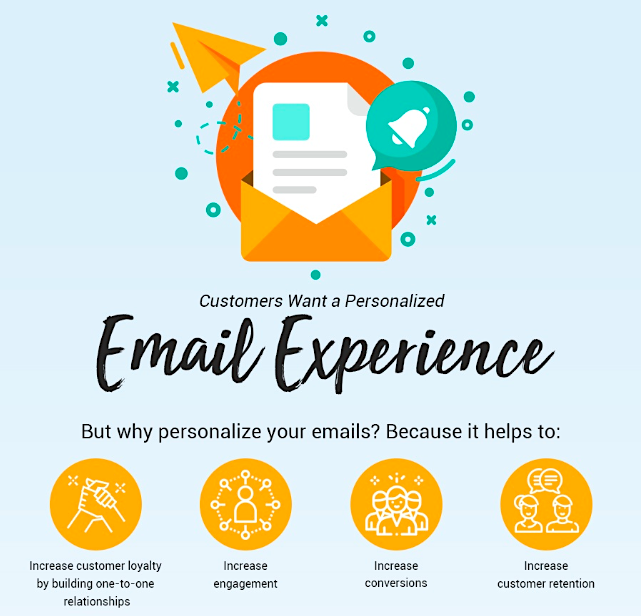
- Optimize send times: Use AI to perform predictive analytics and determine the best times to send emails for each segment of your audience. Platforms like GetResponse and Moosend use machine learning algorithms to analyze past engagement data and predict the optimal send times, ensuring your emails are read when recipients are most likely to engage:
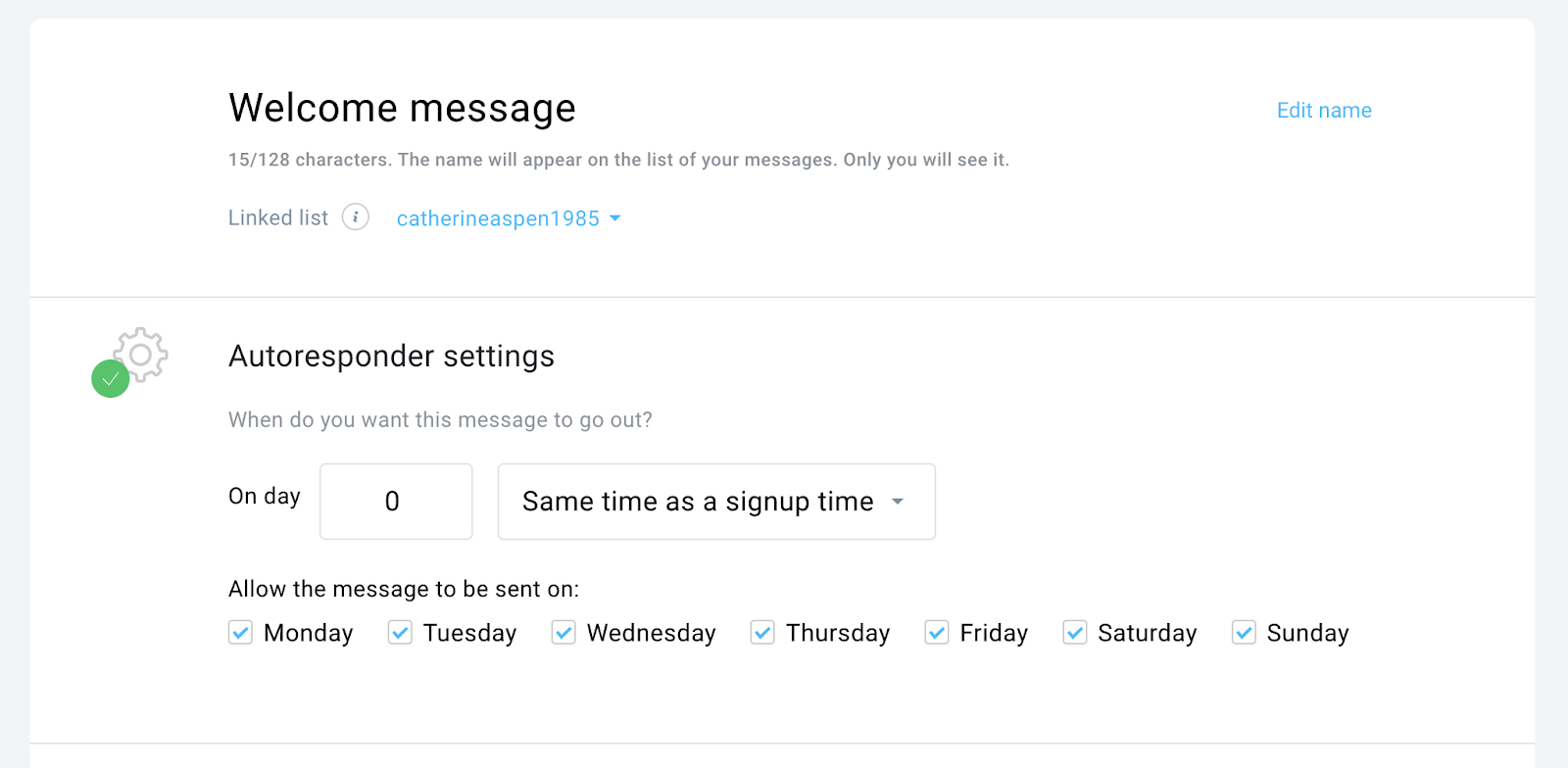
- Automate follow-up emails: Implement automated workflows to send follow-up emails based on user actions. For instance, if a customer abandons their cart, an automated email can remind them to complete their purchase. Tools like ActiveCampaign and Klaviyo excel in creating complex, behavior-driven email workflows.
- A/B test with AI: Use AI to conduct A/B testing on different email elements, such as subject lines, images, and call-to-action buttons. Tools like Seventh Sense can automatically test variations and determine which performs best, helping you refine your email marketing strategy over time.
- Measure and analyze performance: Regularly track and analyze the performance of your email campaigns using AI analytics tools. Solutions like Google Analytics and HubSpot provide insights into open rates, click-through rates, and conversion metrics, helping you adjust your strategies for better results.
Key Takeaway: Add AI to your email marketing strategy to create more personalized, timely, and relevant campaigns that drive higher engagement and conversions.
5. AI-Powered Content Translation
Ready to take your marketing efforts global? Reaching audiences all over the world is easier than ever thanks to AI-powered content translation.
You can use AI to translate website content, marketing materials, and even customer interactions, ensuring consistency and accuracy across different languages and regions.
It’s a strategy that works quite well. YouTuber MrBeast, for instance, used AI dubbing to create YouTube channels in different languages and expand his reach internationally:
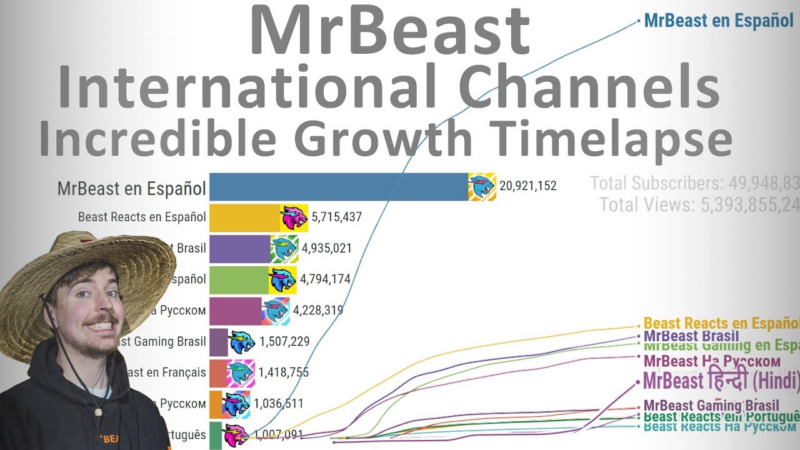
Spotify also recently announced AI voice translations for English-language podcasts hosted on the platform to make them accessible to users in Swahili, Hindi, French, German, and more!
Below are some practical tips for using AI in content translation:
- Automate website localization: Use AI tools like Google Translate, DeepL, or Microsoft Translator to automatically translate your website content into multiple languages. This ensures your message reaches a global audience without the need for manual translation:
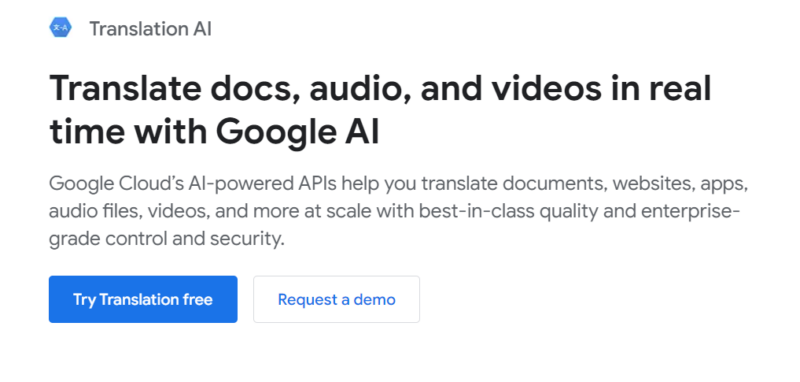
- Translate marketing materials: Utilize generative AI to translate emails, brochures, and other marketing materials. However, make sure a human reviews the materials to maintain consistency and accuracy across different languages and regions.
- Multilingual chatbots: Implement AI-powered chatbots that can communicate in multiple languages. This provides customer support and engagement in users’ preferred languages, improving the customer experience.
- Video subtitles and captions: Use AI to generate and translate subtitles and captions for videos. Adding captions is a popular strategy for increasing viewership on YouTube, and YouTube Studio offers multilingual support for subtitles and descriptions to make your content accessible to non-native speakers:
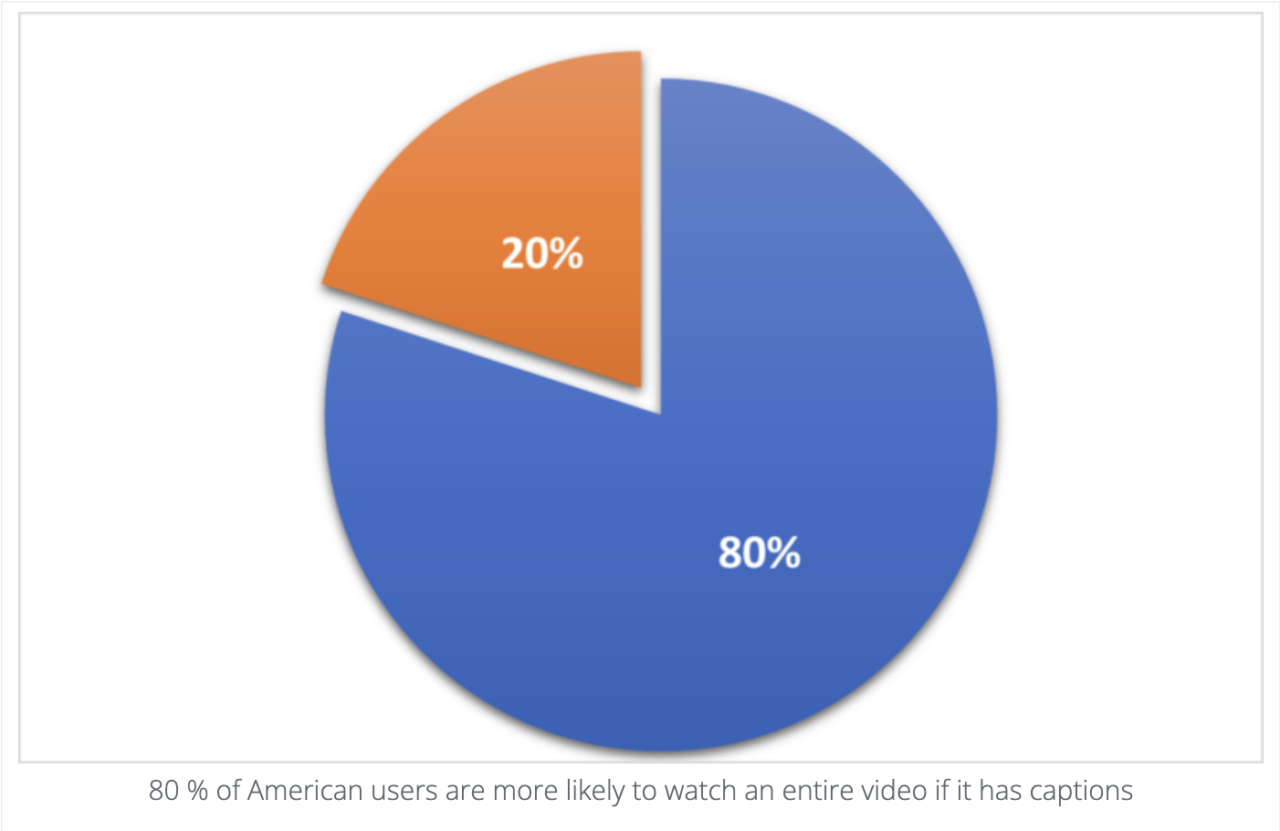
- Content management systems: Integrate AI translation services into your CMS to automate the translation of blog posts, articles, and other content types. WordPress, for example, has dozens of plugins for multilingual support.
Key Takeaway: Using AI for content translation can help you maintain consistency and accuracy across different languages, making it easier to connect with a global audience and expand your digital marketing reach.
7. Dynamic Pricing Using AI
Dynamic pricing was popularized by the travel and airline industries, where prices are constantly changing based on supply and demand. This tactic is now trickling down to ecommerce, retail, and transportation services.
By using AI, digital marketers can dynamically change prices based on real-time factors like competition, demand, and supply. However, while this can have many advantages, it could lead to customer dissatisfaction if implemented poorly.
You have to be careful not to overuse dynamic pricing or you might create perceptions of unfairness.
Here are some practical tips:
- Monitor market trends: Use AI tools like Feedvisor and Minderest to track real-time market trends and competitor pricing. This allows you to adjust your prices dynamically to stay competitive and capitalize on market opportunities:
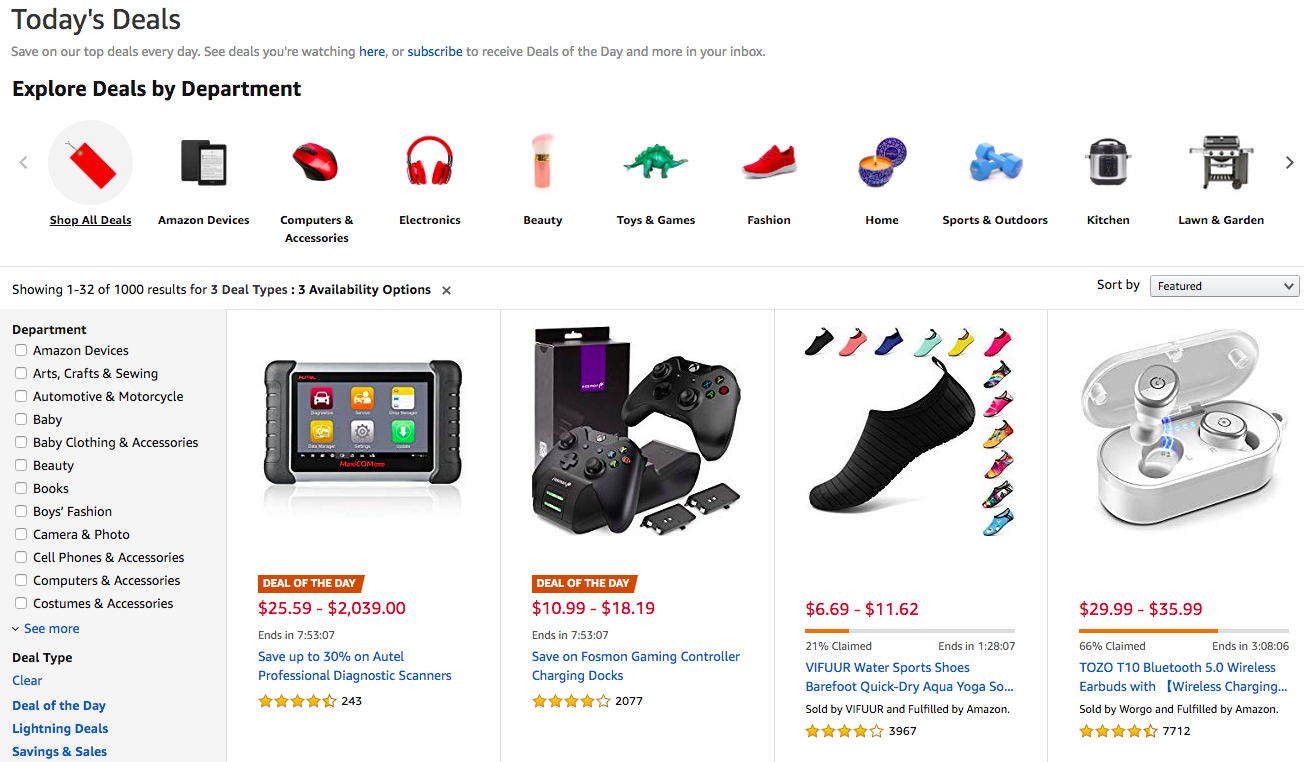
- Analyze customer behavior: AI can help you understand how different customer segments respond to price changes. Tools like Dynamic Pricing by NetRivals and Competera can analyze purchasing patterns and elasticity, helping you set prices that maximize sales and profitability.
- Adjust prices in real-time: Implement AI systems that can adjust prices in real-time based on demand, inventory levels, and other factors. Platforms like Prisync and BlackCurve automate this process and ensure your prices are always optimized for current market conditions:

- Segment pricing strategies: Use AI to develop different pricing strategies for various customer segments. This can include personalized discounts, special offers, and loyalty rewards. Tools like PROS Price Optimization can help tailor your pricing to different customer needs and behaviors.
Key Takeaway: Adding AI into your dynamic pricing strategies can help you stay competitive, optimize revenue, and better meet market demands.
8. Social Media Management with AI
With so many social media platforms to manage, keeping up with posts, comments, and trends can feel overwhelming.
That’s where AI steps in to save the day! AI-powered tools can streamline your social media management by automating tasks, generating content ideas, and providing insightful analytics.
Pro tip: Unsure which social media sites to use? Read our guide on which social media sites to focus on in 2024 and why.
Below are some tips we recommend for using AI in social media management:
- Automate content scheduling: Use AI tools like Hootsuite and Buffer to automate your content scheduling. At Single Grain, we consistently create and schedule content for our audience and use Sprout Social for scheduling and reporting:
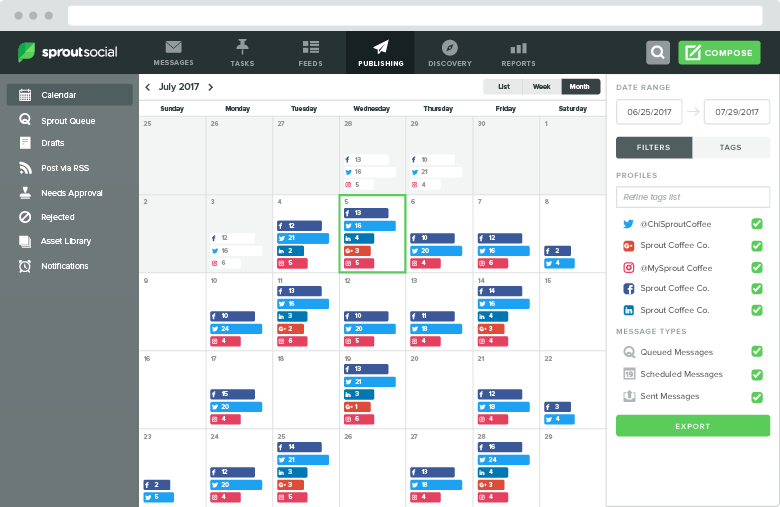
- Generate content ideas: AI is a great tool for generating fresh and relevant content ideas. Tools like BuzzSumo can analyze trending topics and audience interests and help you create content that resonates with your followers.
- Personalize interactions: We touched on this in the section on chatbots but to reiterate — as part of your AI marketing strategy, use AI chatbots on your social media platforms to provide instant responses to customer inquiries. Tools like ManyChat and Chatfuel can handle common questions and direct more complicated questions to your customer service team.
- Analyze social media performance: Keep an eye on your engagement metrics, audience demographics, and sentiment analysis. These variables can help you refine your strategy for better results:
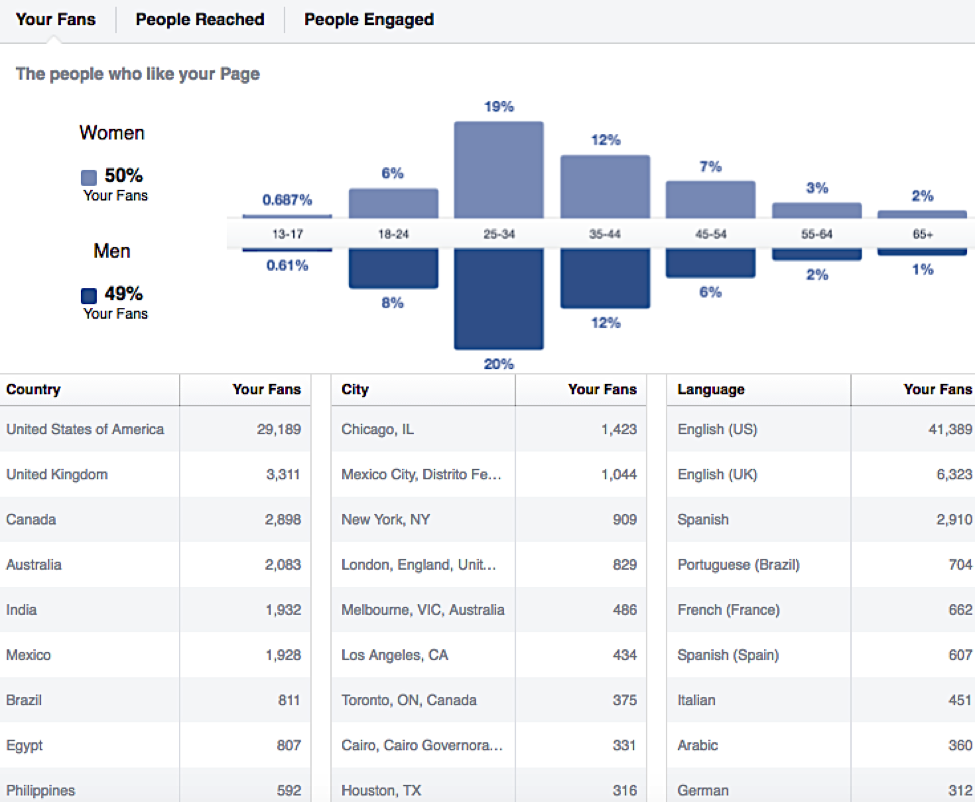
- Enhance visual content: AI can help you create eye-catching visuals for your social media posts. Tools like Canva and Adobe Spark use AI to suggest design elements, colors, and layouts based on current trends and best practices. Check out this guide on creating images with AI for more information:
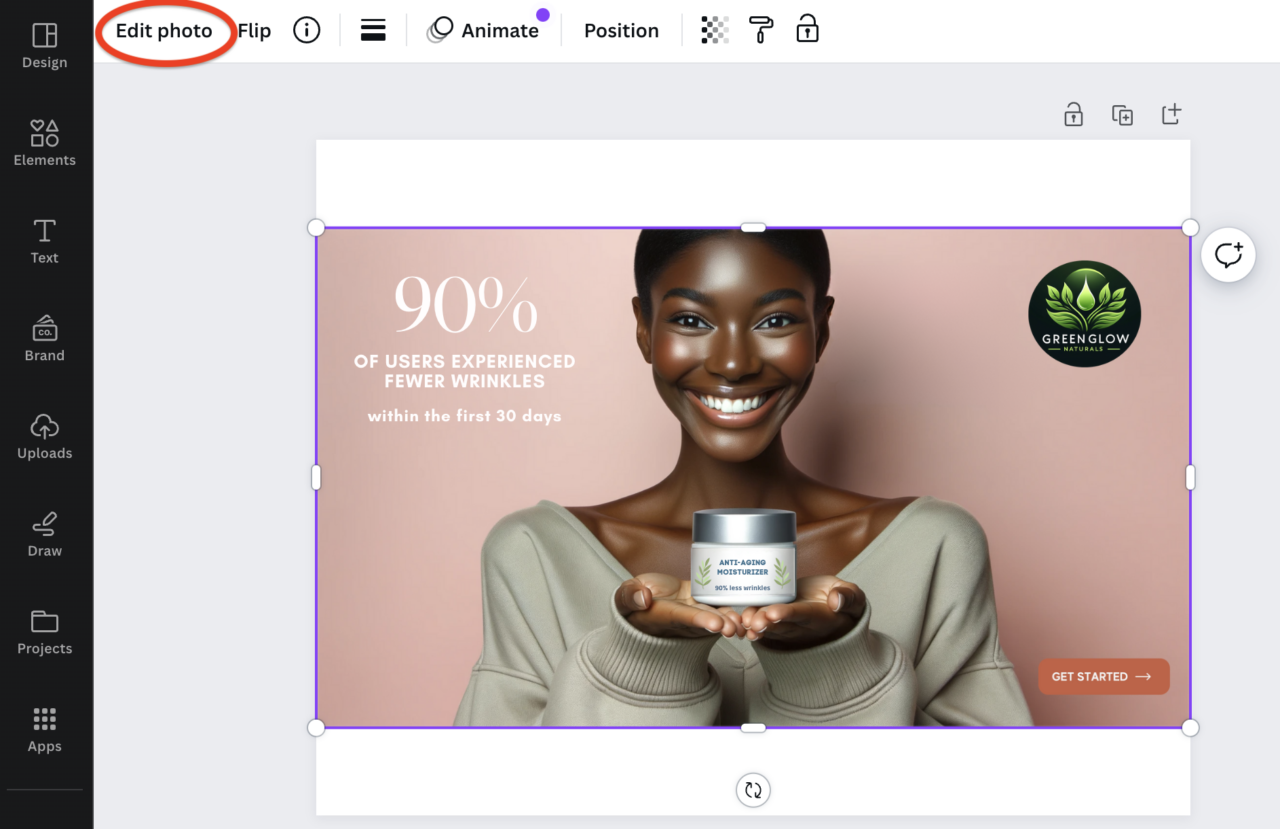
- Monitor brand mentions: Use AI to monitor social media for mentions of your brand, products, or industry. Tools like Mention can track conversations and sentiment in real-time, allowing you to engage with your audience and manage your online reputation effectively.
Key Takeaway: By adding AI to your social media management strategy, you can automate routine tasks, generate engaging personalized content, and gain valuable insights into your audience.
9. Customer Journey Optimization Using AI
The path to converting a prospect to a buyer is a winding one, full of twists and turns, that often requires a map.
A
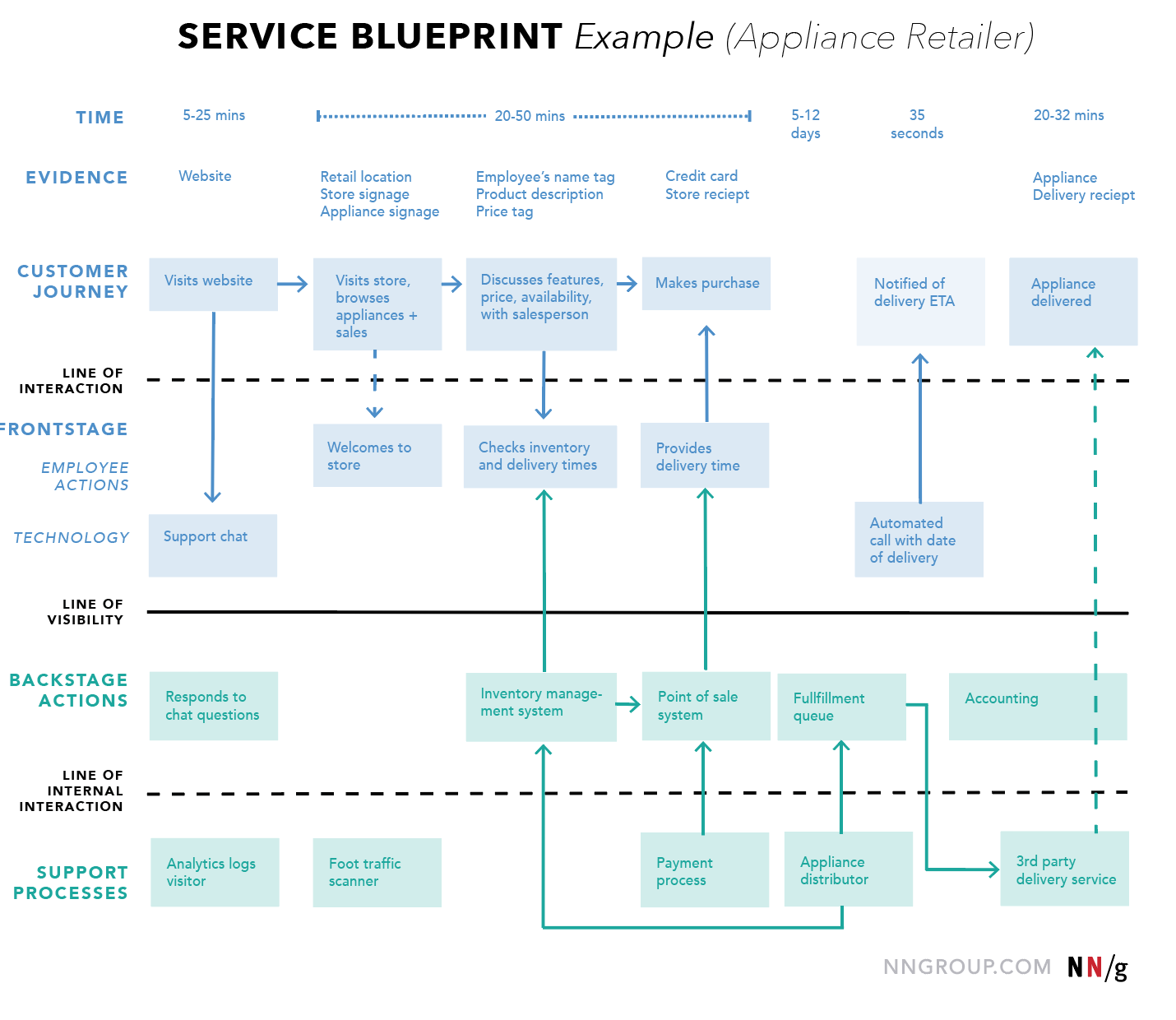
With AI-powered customer journey optimization, you can navigate this path more effectively. By analyzing data from every touchpoint, AI helps you understand customer behavior and personalize their experience, making the journey smoother and more engaging.
Here are some practical tips for using AI in customer journey optimization:
- Map customer journeys with AI: Use AI tools like Salesforce and Adobe Experience Cloud to track and map customer interactions across various channels. This helps you visualize the entire customer journey and identify areas for improvement.
- Predict customer needs: Leverage AI to predict customer needs and behaviors based on past interactions. Tools like Pega and Optimove analyze data to anticipate what customers might need next, allowing you to proactively address their needs.
- Personalize experiences: Implement AI-driven personalization to tailor the customer experience. Platforms like Dynamic Yield and Evergage use AI to customize content, product recommendations, and offers based on individual customer preferences. In one case study, Dynamic Yield helped Sephora SEA generate 6X ROI by implementing personalized AI-based recommendations:

Key Takeaway: By integrating AI into your customer journey optimization efforts, you can create more personalized, seamless, and satisfying experiences for your customers.
10. AI-Powered Ad Targeting and Retargeting
Struggling to get your ads in front of the right people? AI-powered ad targeting and retargeting can help.
By crunching vast amounts of data, AI identifies your ideal audience and tailors ads specifically for them. This is key if you want to reach the right audience with the right message at the right time.
Not sure where to start with targeting and retargeting? Check out our
Below are practical tips we recommend for using AI in ad targeting and retargeting:
- Optimize ad spend: Leverage AI to optimize your ad spend in real-time. Marketing solutions like Criteo use machine learning to adjust bids based on performance data to ensure you get the best return on investment. Proper optimization can be complex, which is why we’ve written a comprehensive guide on how to optimize your PPC ads to boost performance.
- Retarget potential customers: Use AI-powered retargeting to re-engage users who have previously interacted with your brand. Platforms like AdRoll can track user behavior and serve relevant ads to remind them of your products or services, encouraging them to complete their purchase:

- Analyze ad performance: Continuously monitor and analyze ad performance using AI tools. There are numerous audit tools that provide detailed metrics on ad effectiveness across all platforms, allowing you to refine your strategies and improve future campaigns.
Key Takeaway: By including AI in your ad targeting and retargeting efforts, you can deliver more personalized and effective ads, optimize your budget, and ultimately drive higher conversion rates.
Final Thoughts on AI Marketing Strategies and Automation
AI is changing digital marketing in big ways. From setting prices to understanding customer journeys and targeting ads, AI marketing tools are helping businesses work smarter and connect better with their audience.
But while AI can handle a lot of data and automate tasks, the human touch is still important. Creativity, empathy, and understanding come from people. Combining AI-powered marketing with human skills ensures your strategy feels personal and genuine.
Using AI algorithms in marketing isn’t just about keeping up; it’s about getting ahead. As AI grows, its impact will increase. By using AI wisely, you can improve your marketing, engage your audience, and achieve more success.
